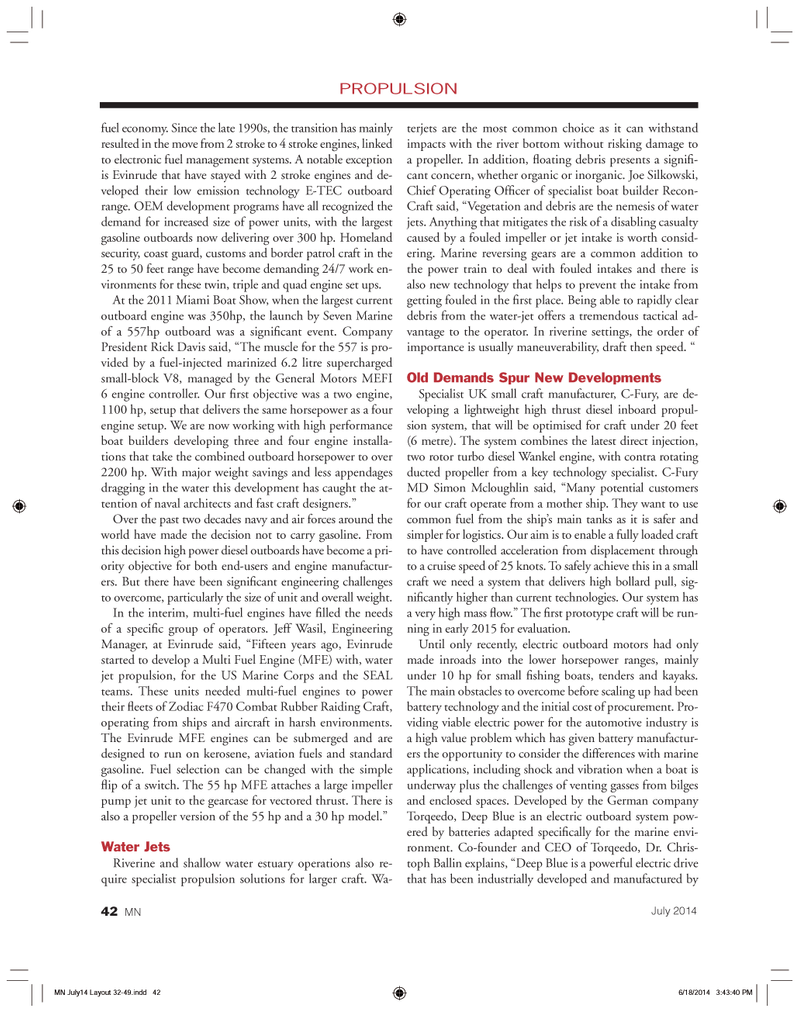
Page 42: of Marine News Magazine (July 2014)
ATB Technical Trends
Read this page in Pdf, Flash or Html5 edition of July 2014 Marine News Magazine
fuel economy. Since the late 1990s, the transition has mainly resulted in the move from 2 stroke to 4 stroke engines, linked to electronic fuel management systems. A notable exception is Evinrude that have stayed with 2 stroke engines and de- veloped their low emission technology E-TEC outboard range. OEM development programs have all recognized the demand for increased size of power units, with the largest gasoline outboards now delivering over 300 hp. Homeland security, coast guard, customs and border patrol craft in the 25 to 50 feet range have become demanding 24/7 work en- vironments for these twin, triple and quad engine set ups. At the 2011 Miami Boat Show, when the largest current outboard engine was 350hp, the launch by Seven Marine of a 557hp outboard was a signiÞ cant event. Company President Rick Davis said, ÒThe muscle for the 557 is pro- vided by a fuel-injected marinized 6.2 litre supercharged small-block V8, managed by the General Motors MEFI 6 engine controller. Our Þ rst objective was a two engine, 1100 hp, setup that delivers the same horsepower as a four engine setup. We are now working with high performance boat builders developing three and four engine installa- tions that take the combined outboard horsepower to over 2200 hp. With major weight savings and less appendages dragging in the water this development has caught the at- tention of naval architects and fast craft designers.Ó Over the past two decades navy and air forces around the world have made the decision not to carry gasoline. From this decision high power diesel outboards have become a pri- ority objective for both end-users and engine manufactur- ers. But there have been signiÞ cant engineering challenges to overcome, particularly the size of unit and overall weight. In the interim, multi-fuel engines have Þ lled the needs of a speciÞ c group of operators. Jeff Wasil, Engineering Manager, at Evinrude said, ÒFifteen years ago, Evinrude started to develop a Multi Fuel Engine (MFE) with, water jet propulsion, for the US Marine Corps and the SEAL teams. These units needed multi-fuel engines to power their ß eets of Zodiac F470 Combat Rubber Raiding Craft, operating from ships and aircraft in harsh environments. The Evinrude MFE engines can be submerged and are designed to run on kerosene, aviation fuels and standard gasoline. Fuel selection can be changed with the simple ß ip of a switch. The 55 hp MFE attaches a large impeller pump jet unit to the gearcase for vectored thrust. There is also a propeller version of the 55 hp and a 30 hp model.Ó Water Jets Riverine and shallow water estuary operations also re- quire specialist propulsion solutions for larger craft. Wa- terjets are the most common choice as it can withstand impacts with the river bottom without risking damage to a propeller. In addition, ß oating debris presents a signiÞ -cant concern, whether organic or inorganic. Joe Silkowski, Chief Operating OfÞ cer of specialist boat builder Recon- Craft said, ÒVegetation and debris are the nemesis of water jets. Anything that mitigates the risk of a disabling casualty caused by a fouled impeller or jet intake is worth consid- ering. Marine reversing gears are a common addition to the power train to deal with fouled intakes and there is also new technology that helps to prevent the intake from getting fouled in the Þ rst place. Being able to rapidly clear debris from the water-jet offers a tremendous tactical ad- vantage to the operator. In riverine settings, the order of importance is usually maneuverability, draft then speed. Ò Old Demands Spur New DevelopmentsSpecialist UK small craft manufacturer, C-Fury, are de- veloping a lightweight high thrust diesel inboard propul- sion system, that will be optimised for craft under 20 feet (6 metre). The system combines the latest direct injection, two rotor turbo diesel Wankel engine, with contra rotating ducted propeller from a key technology specialist. C-Fury MD Simon Mcloughlin said, ÒMany potential customers for our craft operate from a mother ship. They want to use common fuel from the shipÕs main tanks as it is safer and simpler for logistics. Our aim is to enable a fully loaded craft to have controlled acceleration from displacement through to a cruise speed of 25 knots. To safely achieve this in a small craft we need a system that delivers high bollard pull, sig- niÞ cantly higher than current technologies. Our system has a very high mass ß ow.Ó The Þ rst prototype craft will be run- ning in early 2015 for evaluation. Until only recently, electric outboard motors had only made inroads into the lower horsepower ranges, mainly under 10 hp for small Þ shing boats, tenders and kayaks. The main obstacles to overcome before scaling up had been battery technology and the initial cost of procurement. Pro- viding viable electric power for the automotive industry is a high value problem which has given battery manufactur- ers the opportunity to consider the differences with marine applications, including shock and vibration when a boat is underway plus the challenges of venting gasses from bilges and enclosed spaces. Developed by the German company Torqeedo, Deep Blue is an electric outboard system pow- ered by batteries adapted speciÞ cally for the marine envi- ronment. Co-founder and CEO of Torqeedo, Dr. Chris- toph Ballin explains, ÒDeep Blue is a powerful electric drive that has been industrially developed and manufactured by PROPULSION42 MNJuly 2014MN July14 Layout 32-49.indd 42MN July14 Layout 32-49.indd 426/18/2014 3:43:40 PM6/18/2014 3:43:40 PM

 41
41

 43
43
